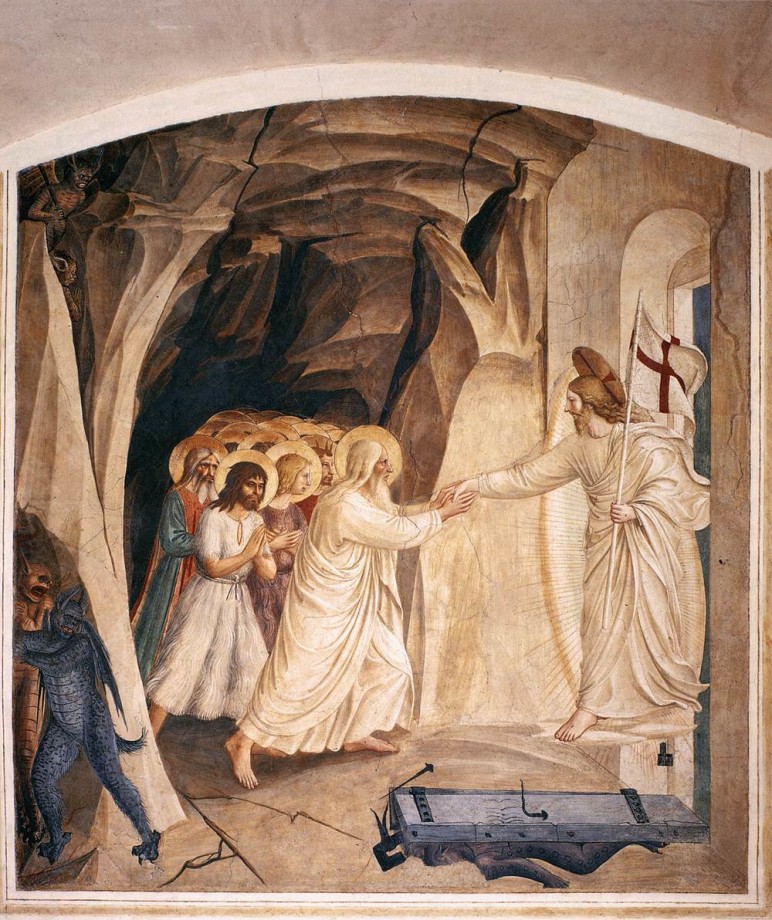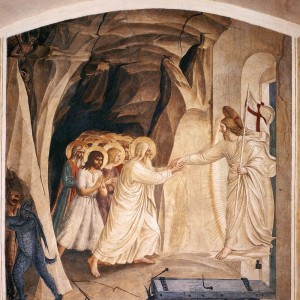In my opinion, Holy Saturday is the hardest day of Holy Week to really “enter into.” Is it a day of mourning? Not exactly. A day of rejoicing? Again, not exactly. The best description I’ve heard it is that it is a day of “quiet hope.” Here are some aids to cultivate a spirit of quiet hope as we make the massive transition from Good Friday to Easter Sunday, and as we commemorate Christ’s “harrowing of hell”:
Hymn: Tibi, Redemptor Omnium
This Latin hymn, from the 5th or 6th century, is one of relatively few to speak about Christ’s descent into Hell. You can hear it here. In English, it goes like this:
Redeemer of our fallen race
With contrite hearts we sing to you;
Forgive us, Lord, we humbly pray,
Forgive us who confess your Name.The pow’r of Satan and his hordes
You broke by death upon the Cross;
Signed on the forehead with this seal
We bear the banner of our faith.His grim dominion over us
You deigned to shatter and dispel,
Lest he for ever should do harm
To souls once ransomed by your Blood.You visited the gloom of hell
To lead to everlasting joy
The faithful of the ancient Law,
Awaiting you in silent hope.
Alone you know the certain time
When this our world must pass away,
And when as Judge of every soul
You will award what justice claims.So heal our wounds we beg this day,
O Savior Jesus Christ, our Lord,
Who with the Father will be praised
For ever with your Spirit’s Love. Amen.
Scripture: The Sign of Jonah
When pressed for a sign, Jesus more than once responds that the only sign to be given would be the “Sign of Jonah” (Matthew 12:38-39; Mt. 16:4). It’s a mysterious and multi-layered response. Part of the Sign of Jonah seems to be about the destruction of Jerusalem (Nineveh was given forty days to repent or be destroyed; Jerusalem was given forty years, and was destroyed in 70 A.D.). But it’s also about the Passion and Death of Christ, His descent into Hell, and His Resurrection. Jesus gives this explanation Himself, saying: “For as Jonah was three days and three nights in the belly of the whale, so will the Son of man be three days and three nights in the heart of the earth” (Mt. 12:40).
In light of this connection, the prayer that Jonah offers from the belly of the whale takes on a profound Christological significance in its connection to Holy Saturday (during which we commemorate Jesus being in the “heart of the earth”). Here’s Jonah’s hopeful prayer from the deep (Jonah 2:2-9):
I called to the Lord, out of my distress, and he answered me; out of the belly of Sheol I cried, and thou didst hear my voice. For thou didst cast me into the deep, into the heart of the seas, and the flood was round about me; all thy waves and thy billows passed over me.
Then I said, ‘I am cast out from thy presence; how shall I again look upon thy holy temple?’ The waters closed in over me, the deep was round about me; weeds were wrapped about my head at the roots of the mountains. I went down to the land whose bars closed upon me for ever; yet thou didst bring up my life from the Pit, O Lord my God.
When my soul fainted within me, I remembered the Lord; and my prayer came to thee, into thy holy temple. Those who pay regard to vain idols forsake their true loyalty. But I with the voice of thanksgiving will sacrifice to thee; what I have vowed I will pay. Deliverance belongs to the Lord!”
Religious Art: Fra Angelico, Christ in Limbo (1442)
The Apostle’s Creed says that Christ “descended into hell,” and St. Paul, comments on a prophecy in Psalm 68:18 (“When he ascended on high he led a host of captives, and he gave gifts to men”), by asking, “In saying, ‘He ascended,’ what does it mean but that he had also descended into the lower parts of the earth?” (Ephesians 4:8-9). And as we just saw, Jesus speaks to this directly, when He describes His mission to spend three days descending into (and arising from) the “heart of the earth” (Mt. 12:40).
But what Jesus, Paul, and the Creed mean isn’t that Christ went and suffered the pain of damnation. “Hell” is the ancient description of both the place of damnation, and the resting place of the just (where they awaited their redemption and liberation by Jesus Christ). As the Catechism confirms, “Jesus did not descend into hell to deliver the damned, nor to destroy the hell of damnation, but to free the just who had gone before him.” Graphically, this liberation is represented by Fra Angelico’s 1442 painting Christ in Limbo:

Perhaps the most powerful part of this image is the demon crushed under the door of hell that Jesus Christ burst opened in His liberation.
Spiritual Reading: The Lord’s Descent into Hell
What Fra Angelico depicts in paint, this anonymous orator depicts in a beautiful ancient homily preached on Holy Saturday:
“What is happening? Today there is a great silence over the earth, a great silence, and stillness, a great silence because the King sleeps; the earth was in terror and was still, because God slept in the flesh and raised up those who were sleeping from the ages. God has died in the flesh, and the underworld has trembled.
Truly he goes to seek out our first parent like a lost sheep; he wishes to visit those who sit in darkness and in the shadow of death. He goes to free the prisoner Adam and his fellow-prisoner Eve from their pains, he who is God, and Adam’s son.
The Lord goes in to them holding his victorious weapon, his cross. When Adam, the first created man, sees him, he strikes his breast in terror and calls out to all: ‘My Lord be with you all.’ And Christ in reply says to Adam: ‘And with your spirit.’ And grasping his hand he raises him up, saying: ‘Awake, O sleeper, and arise from the dead, and Christ shall give you light.
‘I am your God, who for your sake became your son, who for you and your descendants now speak and command with authority those in prison: Come forth, and those in darkness: Have light, and those who sleep: Rise.
‘I command you: Awake, sleeper, I have not made you to be held a prisoner in the underworld. Arise from the dead; I am the life of the dead. Arise, O man, work of my hands, arise, you who were fashioned in my image. Rise, let us go hence; for you in me and I in you, together we are one undivided person.
‘For you, I your God became your son; for you, I the Master took on your form; that of slave; for you, I who am above the heavens came on earth and under the earth; for you, man, I became as a man without help, free among the dead; for you, who left a garden, I was handed over to Jews from a garden and crucified in a garden.
‘Look at the spittle on my face, which I received because of you, in order to restore you to that first divine inbreathing at creation. See the blows on my cheeks, which I accepted in order to refashion your distorted form to my own image.
‘See the scourging of my back, which I accepted in order to disperse the load of your sins which was laid upon your back. See my hands nailed to the tree for a good purpose, for you, who stretched out your hand to the tree for an evil one.
`I slept on the cross and a sword pierced my side, for you, who slept in paradise and brought forth Eve from your side. My side healed the pain of your side; my sleep will release you from your sleep in Hades; my sword has checked the sword which was turned against you.
‘But arise, let us go hence. The enemy brought you out of the land of paradise; I will reinstate you, no longer in paradise, but on the throne of heaven. I denied you the tree of life, which was a figure, but now I myself am united to you, I who am life. I posted the cherubim to guard you as they would slaves; now I make the cherubim worship you as they would God.
“The cherubim throne has been prepared, the bearers are ready and waiting, the bridal chamber is in order, the food is provided, the everlasting houses and rooms are in readiness; the treasures of good things have been opened; the kingdom of heaven has been prepared before the ages.”
Saint of the Day: Saint Eustochium Julia
Saint Eustochium Julia (368-420) was the Roman-born daughter of St. Paula. Both she and her mother had St. Jerome as a spiritual director. Jerome mentions in the last chapter of De Viris Illustribus (On Illustrious Men), “how many letters I have written to Paula and Eustochium I do not know, for I write daily.” Eustochium and her mother followed Jerome from Rome to Egypt and eventually to Bethlehem. There, as the Catholic Encyclopedia notes, the pair of them established three “nunneries” in Bethlehem, while Jerome worked to established a monastery. In a lengthy letter praising her (and consoling her after the death of her mother), Jerome described Eustochium as “a precious necklace of virginity and of the church.” He also mentions something remarkable — that Paula and Eustochium were more fluent in Hebrew than Jerome himself:
While I myself beginning as a young man have with much toil and effort partially acquired the Hebrew tongue and study it now unceasingly lest if I leave it, it also may leave me; Paula, on making up her mind that she too would learn it, succeeded so well that she could chant the psalms in Hebrew and could speak the language without a trace of the pronunciation peculiar to Latin. The same accomplishment can be seen to this day in her daughter Eustochium, who always kept close to her mother’s side, obeyed all her commands, never slept apart from her, never walked abroad or took a meal without her, never had a penny that she could call her own, rejoiced when her mother gave to the poor her little patrimony, and fully believed that in filial affection she had the best heritage and the truest riches.
Bear in mind that Jerome was the translator of the Latin Vulgate, and famously fluent in Hebrew, Greek, and Latin; this is high praise indeed. And as the rest of the letter shows, Eustochium wasn’t simply brilliant: she followed her mother’s example in loving a life of prayer and of service to the poor. St. Eustochium’s feast day is September 28.
